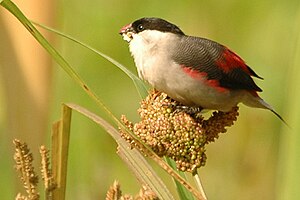Nunnery
| Nunnery | ||||||||||||
|---|---|---|---|---|---|---|---|---|---|---|---|---|

Nun's reeds ( Estrilda nonnula ) |
||||||||||||
| Systematics | ||||||||||||
|
||||||||||||
| Scientific name | ||||||||||||
| Estrilda nonnula | ||||||||||||
| ( Hartlaub , 1883) |
The Black-Crowned Waxbill ( Estrilda nonnula ), also Weißbrüstiger black-headed waxbill or Weißbrüstiges black head called, is an African species of the family of finches . There are three subspecies for this species: ( Estrilda nonnula nonnula ); ( Estrilda nonnula elizae ); ( Estrilda nonnula eisentrauti ).
description
Nonnenastrilde reach a body length of 10.5 centimeters. They weigh between 6.5 and 9 grams. The males have black reins, a black eye area and a black skull. The upper back, the wing covers and the arm wings are light ash gray. Similar to the Kappenastrild , the arm wings are finely banded black across. The rump and the upper tail-coverts are bright red. The sides of the body are also red, albeit less extensive than in the Kappenastrild. The chin, throat and sides of the head are white. The rest of the underside of the body is white to whitish gray, depending on the subspecies. The eyes are brown. The bill is black with a red stripe on each side of the upper bill and a red patch at the base of the lower bill.
The females differ only slightly from the males. The basic color on the upper side of the body is a little more brown-gray. The transverse ligament is also brown and finer than in the male. Young birds still lack the dark transverse undulations.
Distribution and way of life
The distribution area of the Nonnenastrild extends from Benin and the east of Nigeria to the west of Kenya , the Cameroon Mountain and the south and interior of Cameroon to Gabon . They are also found in the highland region in the east of the Democratic Republic of the Congo . Their distribution area extends from Lake Albert to the northwestern shore of Lake Tanganyika and via Rwanda to the western shore of Lake Victoria . In Uganda , Rwanda and Burundi , the distribution area overlaps with that of the black-capped deer .
The Nonnenastrild is very adaptable and inhabits a number of very different biotopes. It occurs in savannahs that are streaked with trees and bushes, in places also on bare plateaus, in napier grass and bamboo stands, in weed meadows, on forest edges and in grassy forest clearings. It has also opened up human settlement space and occurs in gardens and fields. It occurs on the Cameroon Mountain at altitudes of 3,000 meters. In East Africa, its altitude distribution is generally lower.
Nuns are very sociable birds and live in flocks after the breeding season. Occasionally, thousands of them gather in ripe grain fields. They also prey on flying insects in flight. Their diet, however, is dominated by annual grasses, including above all millet . The breeding season varies depending on the area of distribution and generally falls at the end of the rainy season. The nest is built well hidden in small trees, bushes and hedges. As with a number of other beautiful African finches, there is often a cock's nest above the actual nest . The clutch consists of three to six white eggs.
attitude
Nonnenastrilde were first introduced to London in 1935 on behalf of the Zoological Society of London . In the same year some birds of this species came to Germany. Since around 1960 they have been on the market in smaller numbers. They were only introduced in large numbers shortly before the change into the 21st century. Nuns have a high need for light and must be irradiated with an artificial UV source if they are kept in indoor aviaries to prevent the birds from balding.
supporting documents
literature
- Jürgen Nicolai (Ed.), Joachim Steinbacher (Ed.), Renate van den Elzen, Gerhard Hofmann, Claudia Mettke-Hofmann: Prachtfinken - Afrika , Series Handbuch der Vogelpflege, Eugen Ulmer Verlag, Stuttgart 2007, ISBN 978-3-8001- 4964-3
Web links
- Estrilda nonnula inthe IUCN 2013 Red List of Threatened Species . Listed by: BirdLife International, 2012. Retrieved November 24, 2013.
Single receipts
- ↑ Nicolai et al., P. 261 and p. 262
